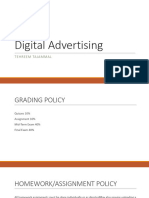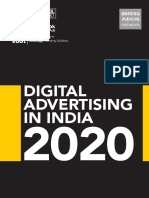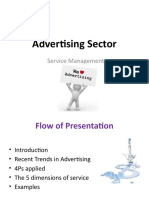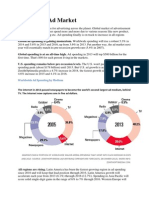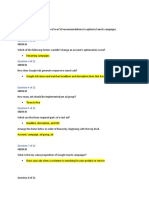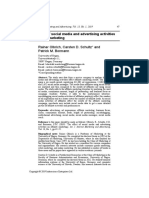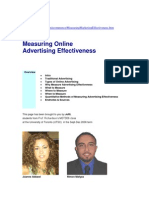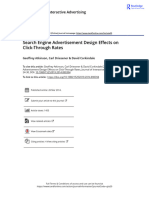MGT 6311 PAID ADVERTISING TRANSCRIPT
M2L1 Trends in Display Advertising Spending
>> Hi, welcome to the module on display advertising. In the previous module we emphasized key
differences between traditional and digital marketing, hiighlighted important changes in consumer
behaviors. Revisited core strategic concepts and models and ended with a framework for digital
strategy. Now that we have a solid foundation, I'll begin to dive deeper into the various channels
associated with digital marketing, including this module dedicated to the topic of display advertising.
So in this first lesson, I wanna talk about the spending side of display advertising and how marketers are
currently allocating funds across this channel. So I'll provide insights into understanding digital's position
in the broader context of media spend. Create familiarity with digital ad spend across various digital
specific channels.
And share insights related to programmatic's growing role in digital advertising. When we look at the
channels marketers are leveraging within the United States for advertising, we see trends indicating the
traditional channels such as TV, print, radio, and out-of-home are generally declining in overall market
share, while digital forms of advertising are increasing.
TV has had a long standing position of being far and away, the channel leader in advertising spin
historically speaking. As noted previously, digital is overtaking TV and projected to be significantly
greater within the next few years. This doesn't necessarily indicate that what marketers are doing is
correct, but it does highlight the channels that marketers believe to be most significant and most
valuable in terms of ad spend.
Also, note that this data set is highlighting 2020 and projections for 2021. The COVID-19 pandemic had a
major impact on marketing behaviors, including advertising. Some of the 2021 projections are a function
of rebounding from necessary changes imposed in 2020. The biggest standout here is advertising within
the cinema channel.
Within digital specifically, we observe ad spending trends indicating marketers are in aggregate, favoring
certain digital channels over others. As a percentage of total digital ad spend, we see investment in
search and various forms of display advertising, such as paid social media ads and retargeting display ads
increasing the most.
Which makes perfect sense with respect to aligning with where consumers are spending their time. The
first display ad was purchased and displayed by AT&T back in 1994. Quite a lot has changed since that
1
�time. If you've been around digital marketing or the advertising industry in recent years, you've heard
certain terms and concepts regularly and programmatic is one of these terms.
Programmatic ad buying is the use of software to buy digital advertising. It is not however, the complete
automation of the ad buying process. So traditionally, you would have manually prepared insertion
orders or ad tags which can be menial but labor intensive. With programmatic ads, humans have more
time for the optimization and improvement of ads.
The system will not only launch your campaign, but it will also monitor your ad spend to look for areas
of improvement. And that's a key point here, thus providing distinct efficiencies related to the
alternatives. Naturally, we see an increase in programmatic ad buying to better realize these efficiencies.
Although I don't intend to take a deep dive into programmatic, I did wanna bring it up for familiarity, as
well as to reinforce the notion that technology and artificial intelligence continues to expand in digital
marketing, even in the realm of display advertising. This concludes the lesson on display advertising
spending trends.
In the next lesson, I'll talk about goals related to display advertising, and some of the important
considerations we want to contemplate when assessing and activating this digital marketing channel.
M2L2 Goals of Display Advertising
>> Now that I've provided a brief overview of display advertising spending trends, I want for us to
consider the appropriate goals related to using display advertising. In this lesson, I'll highlight key display
advertising goals, and discuss limitations and situational considerations associated with display
advertising. Display advertising has the potential to serve multiple marketing goals.
Keep in mind, however, that when customers do not have familiarity with a brand, they may be unlikely
to engage or interact. In the case of display advertising, this lack of involvement might translate to not
paying attention to the content in the ad or clicking on the ad. So at a high level however, there are
aspects of display advertising that make it a channel conducive to supporting underlying business goals.
These include building brand awareness, increasing share of voice, creating consumer demand,
informing consumers, building brand loyalty, and driving response and sales. This is certainly not an
exhaustive list of goals but rather a guide for us to consider how we might best utilize display advertising
in a practical manner moving forward.
2
�Keep in mind that ideally we want our customers that see our display ads to engage with them and
ultimately click through to our site. With that said, we know it's highly unlikely this will be the case
majority of the time. So it begs the question, what click-through rate is acceptable?
1 in 10, or how about 1 in 100, so just 1%, or furthermore, 1 in 217. This chart indicates average click-
through rate or CTR across various industries and types of marketing for both Google's Search Network
and Google's Display Network. Based upon WordStreams analysis of 3 plus billion dollars in AdWords
spend, the average click-through rate is 3.17% on the Search Network, but just 0.46% on the Display
Network, that's 1 in 217.
So stated differently, roughly 1 in 32 people clicked on a paid search ad, while only 1 in 217 clicked on a
display ad. Although it's probably not surprising to you that the click-through rate on display ads is very
low, it begs the question of why marketers use display ads and in what instances it makes sense to do
so.
Take a few moments and give some thought to this. What are some goals that a brand or organization
might have, where it can make sense to use display advertising? For example, does it matter if it's a B2B
company versus a B2C company? What about if the company is well known such as Under Armour, IBM
or Caterpillar versus less well known and or small to medium sized businesses?
And at what stage of the buyer's journey are display ads are likely to be clicked? Although they're not
necessarily perfect answers to these questions, it's important we align our goals with the expected
consumer behaviors. So this concludes the lesson on display advertising goals. In the next lesson, I'll talk
about display ad formats and capabilities that we can leverage to help increase the likelihood of
consumer engagement and click-through.
M2L3 Display Ad Formats, Position and Capabilities
>> Display ads can be shown via websites, and most social media properties. The format of these ads,
the size and type, are a function of the site displaying the ad. So, in this lesson, I will provide insight into
the various ad formats and capabilities. As well as talk about Ad networks, and the role they play within
the digital marketing ecosystem.
I presume everyone has seen numerous display ads while browsing the web, and interacting with social
platforms. As we can see in this example, Kroger, supermarket and VitaFusion vitamins have display ads
on the Food Network's website. In principle, marketers wanna have their ads displayed on sites that
have some contextual relevance to the products and services they are providing.
3
�Also, take note there are different types of ads that are available for use online. And these include
banner ads, which are images or animations displayed on a website for advertising purposes. And they
can be static, or include rich media like video, or other interactive technologies such as flash, html5,
JavaScript, and so forth.
Another Ad type is the pop-up and pop-under ad. These Ads open in a separate smaller window, either
above the web page, or under the web page as their names suggests. These use to be more common
than they are today, because users have began to leverage technologies that prohibit this behaviour.
But they are still an option for the advertiser. Interstitial banners are ads that are shown when a user is
clicking from one page to the next. You're likely to see these used in situations where a user is reading a
multi-page article online. But, they can be used in other situations as well.
Floating ads typically cover all or most of the web page, and either disappear after a few seconds, or
have a close button in one corner of the Ad. The wallpaper ads are used to take over, or change the
background of a web page. In most instances, these wallpaper ads are not clickable.
They're used merely for branding purposes. That said, it's not uncommon to see banner ads used in
combination with a wallpaper ad. Such that the consumer is provided multiple ads on the same page.
You can actually click on the banner ad to visit the advertisers website. The type of ads a marketer
chooses whether it's a floating ad, interstitial ad, a standard banner ad, etc, should be grounded in their
business goals, and expected consumer behaviours.
Notice how I continue to reinforce this point about consumer behaviour, because that's who we're
trying to reach. And all of this may change from one publishing site to another. As I referenced earlier, in
addition to placing display ads on websites, we can also have them display on social networking sites.
Such as Facebook, and Twitter. In this instance of using social platforms, we do not have the contextual
relevance like we do for standalone websites. But we're often able to better target consumers through
these sites using demographic, behavioural, and geographic data. For example, Facebook has indicated
they collect nearly 100 different data points on consumers.
And marketers can leverage this data to better segment, and target potential customers. To make it
easier for website publishers to accommodate display ads, the industry has created certain standard
sizes. Which are measured in pixels. Display ad dimensions are listed in the format of width times height.
The person creating ads can build them to conform to these standards, such that, they can be published
appropriately.
4
�And, websites that are open to advertising can format their web pages to accommodate ads that fit
these layouts. Digital advertisers want to be conscientious of key goals such as the likelihood their ad
will be viewed once presented on a web page. As well as metrics such as dwell duration.
Dwell duration is the length of time the user remains exposed to an ad, after first engaging with it. In
principle, vertical ad units are most likely to be viewed more regularly. And for longer periods of time as
the user navigates around the web page. Therefore, it's important to design and implement ad sizes that
are most likely to achieve your advertising goals.
While also balancing the expense associated with the various ad sizes. Contrary to popular belief, placing
ads at the very top of the page is not necessarily the optimal ad placement position. Rather, having the
ad placed just above the fold, is generally most optimal based upon recent research. In case you are
wondering, a display ad is considered viewable when 50% of an ads pixels are in view on the screen for a
minimum of one second.
And, this is defined by the Media Rating Council. Most display ads are static ads. Meaning they do not
contain any form of animation or sound associated with them. Having multiple senses engaged tends to
be more effective however. As we can see here, L'OREAL has incorporated video with sound into their
ad.
As well as a call to action to shop now. Naturally, the intention is to better capture the viewers attention,
create a more impactful brand impression. And to realize a click through for the ad. One ad tactic that
can increase engagement is dynamic creative optimization. Which allows marketers to serve distinct sets
of ad creative based upon audience targeted data.
Advertisers can determine the most relevant ad creative down to the individual viewer level. And
identify the best performing ad creative accordingly. As demonstrated in these examples, you can see
this in action. Within the NFL ad, we see team helmets depicted that are localized to the market where
the ad is placed.
Thus we wanna use the Dallas Cowboys helmet for example, with the Dallas marketplace. Cuz it's more
likely to be relevant. In the Walmart example, we see products being targeted to people having, or
taking care of children. If we can glean demographic data that allows us to know someone has a young
child, we can cater the offerings accordingly.
5
�Finally, in the priceline ads, we see them differentiating based upon geographic location. The core
structure of the ads are the same. But the city name, airport code, and background images are specific
to certain regions. Again, what this does is allows the marketer to create a framework for the ad.
And then, have certain elements of the content served up dynamically, based upon target audience
insights. Contextual ads are shown based upon a web pages ad copy. And the ads associated tags to
create a symbiosis of relevance. This occurs in part because of the advertisers efforts associated with
their ad.
But also a function of the ad network, which manages the websites where ads can be published. I'll
discuss ad networks further in just a bit. In this example from tripadvisor, we see an ad from Marriott for
their courtyard location in Boston. Which makes sense because the web page is for the Museum of Fine
Arts, located in Boston.
Here we see an example of what's called retargeting. The Scheller College of Business is serving up a
banner ad on the third party motorauthority.com website based upon the fact that I have visited the
scheller.gatech.edu websites, MBA program pages. What happens behind the scenes is that when the
motorauthority.com website page is being loaded, there is a check on the visitor's device.
Whether it be a laptop, phone, tablet, etc. To determine whether or not, they have visited certain other
websites that match against the ad inventory. They could serve up. If there is a match, the
corresponding ad is served, and the user is retargeted. This activity is captured through cookies on the
user's device.
So, if the user has disabled cookies, or recently cleared their browser cache, the system will not be able
to retarget them. And will serve up a more generic ad. Although not a perfect system, the good news for
marketers is that the vast majority of consumers do not disable cookies on their devices.
Retargeting can also be leveraged on social websites, such as Facebook. This slide demonstrates another
example of retargeting. Here, we see overstock.com serving up two banner ads on Facebook. One in
line, and one on the right side. Although these are not the exact products I was looking at, they are in
the category of products I was looking at.
Which were large area rugs. We also see autotrader.com serving up an ad on the bottom right, that has
the exact vehicle I looked at on their website when searching for a truck for my nephew. If we take a
step back from digital ad formats and capabilities to think about how these ads get distributed across an
array of websites, applications, and social channels.
6
�It's important to understand the role of ad networks. A digital ad network serves as an intermediary
between advertisers and the websites that have opted into the ad network. They provide value in
numerous ways. Including helping advertisers publish their ads at scale, meaning across numerous sites.
Ensuring ads are delivered to sites that align with the advertisers target audience behaviours and
demographics.
They manage pricing. Help geo target ads based upon the user's location when needed. And provide
useful analytics, such as the number of views, how many of times the ad was clicked. And the time of
day the ad was seen, and or clicked. They are not to be confused with an ad exchange.
Which is where unsold advertising spaces placed by publishers, and then bid on by advertisers. So, this
concludes the lesson on Display Ad Formats, Position, and Capabilities. In the next lesson, I'll cover the
various payment models, and tracking data available to marketers when using display ads.
M2L4 Payment Models and Tracking
>> Display advertising is generally not free, and there are several approaches related to how we pay for
these ads. We also wanna familiarize ourselves with the types of data we collect related to display
advertising. In this lesson, I'll share with you the various payment models that are commonly used in
display advertising.
Also talk more about the tracking capabilities of online ads. Multiple payment models exist, but the most
common are the CPM and CPC types. In the CPM model, the advertiser pays for ads in groups of 1,000
impressions. Pricing depends upon several variables including popularity of the site, less sites with more
traffic tend to charge more compared to those with lower traffic volume, how targeted the site is.
So think about a site that might be very specific to certain industry, or demographic versus generic sites,
and overall competition for ads on the site. It's also worth pointing out that rich media ads, such as the
L'Oreal example we saw earlier, generally cost more than standard ads. The CPC model is based upon
cost per click, that's the advertiser only pays when the ad impression is actually clicked.
This model has become more common in recent years within display advertising as marketers realize
overall click through rates are relatively low for display ads compared to some other channels. CPA or
cost per acquisition is a model where payment is made based upon an action taken after the user has
clicked the ad and visited the advertiser site.
7
�This acquisition moment may be defined as actions such as filling out a form, actually purchasing a
product, signing up for an email on newsletter, or downloading a document. A CPA model is rarely used
for display marketing, given the reliance upon an acquisition moment occurring on the advertiser's site,
which is not controllable by the publisher.
A display advertising payment model used by some smaller sites is the fixed cost model, also known as
flat rate approach. In this scenario, the website owner offers up a fixed amount of advertising space for
a fixed fee based upon a period of time, such as a month. Typically, a site that drives very high volume
will utilize a CPM model because they can, while other less volume heavy sites may offer a CPC or
alternative model.
As I mentioned in the previous module, one of the key benefits of digital advertising versus traditional
advertising is access to various types of data and insights. These are just some of the examples of data
that can be collected from banner ads, some of which may or may not be relevant to the advertiser.
Marketers should consider their goals and objectives, and then determine what data they need to make
informed business decisions and to control the publication of their ads accordingly. This concludes the
lesson on payment models and tracking data. In the next lesson, I'll provide examples of display creative
best practices.
M2L5 Display Ad Best Practices
>> Although display and click through rates tend to be very low as we've discussed, there are ways to
improve the likelihood of user engagement. Just like we saw on the L'Oreal example. The following
examples are representative of display ads that contain interactive elements that are intended to
increase this engagement.
This display ad from Pringles contains a call to action that requires the viewer to click on the ad to
explore it further. Using the content, love can be complicated, in combination with the imagery of a
woman with a Pringles can covering her hand being proposed to. The ad intends to explore the viewers
curiosity.
Through a series of interactions, the purpose of the ad is to create a positive emotional response. In this
case humor, or at least attempted humor can keep the user engaged with the ad for a longer period of
time and hopefully create a positive association with Pringle's. Some of the content is arguably edgy,
and just silly.
But clearly the marketing team is attempting to leverage these elements to their advantage. Targeting
their core consumers, which index heavily male. The marketers at Volkswagen are also leveraging an
8
�interactive component in this display ad. They've created a gas pedal in the ad, along with supportive
copy, asking the user to hit the gas.
As you can see, nothing super impressive occurs. But there's some animation along with sound to
further engage the user senses. By encouraging this engagement, the marketer wants to create an
emotional connection to the user that generates curiosity, excitement, and possibly even a sense of
power. In this ad from talking stock, they are engaging the consumer by creating a customizable
experience with the ad which revolves around their products.
Their value proposition is that you can save money by investing a little time to assemble the product.
Through the ad, they allow the user to select a time amount, and then provide an example of what can
be built in that time, along with the price. Let's see another quick example.
Thus they are empowering the user to interact and seek out options, all the while reinforcing the talking
stock brand. In this ad created by Burger King, a mixture of playfulness and humor combined to engage
the user. Notice that the ad is encouraging the user to take control, which might manifest in creativity,
or just plain silliness.
Let's give it a shot. Either way, the playful aspect of this ad lends itself to deeper engagement and brings
the brand at the forefront of the customer's mind. Lipton created this ad to provide an element of
entertainment to the user once they've selected a letter. Just like the previous ads, they're engaging the
user and hopefully creating a positive emotional response that bolsters brand perception, while also
ensuring the brand is top of mind.
In many instances with larger consumer packaged goods brands. The goal is customer retention, such
that the next time they are in a purchase situation where the product is available, the customer will be
more likely to recall and consider the product. This concludes the module on display advertising. In the
next module we'll continue to address digital marketing channels by covering search advertising.
See you soon


















